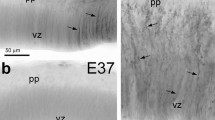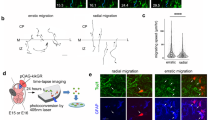Abstract
Formation of myelinated tracts in central nervous system (CNS) regions such as the optic nerve seems to depend on two glial cell types, both of which derive from a common progenitor cell. This oligodendrocyte–type-2 astrocyte (O–2A) progenitor cell gives rise to oligodendrocytes, which produce internodal myelin sheaths, and to type-2 astrocytes, which extend fine processes in the region of the nodal axolemma1,2. The optic nerve also contains a third glial cell, the type-1 astrocyte, which derives from a separate precursor1. These three glial cells develop in a fixed sequence over a two-week period3: type-1 astrocytes appear at embryonic day 16 (E16), oligodendrocytes at the day of birth (E21 or postnatal day P0), and type-2 astrocytes between P8 and P10. Type-1 astrocytes secrete a potent mitogen which causes expansion of the O–2A progenitor cell population in vitro4,5. Here, we report that dividing O–2A progenitor cells are highly motile and seem to migrate from the brain into the optic nerve, beginning at its chiasmal end. Our results indicate that long-distance migration along the neural axis is characteristic only of progenitors of the O–2A lineage and may serve to distribute these cells to regions of the CNS that will become myelinated. These results also suggest that the intrinsic neuroepithelial cells of the optic stalk may be even more restricted than previously thought, giving rise only to type-1 astrocytes.
Similar content being viewed by others
References
1. Raff, M. C., Miller, R. H. & Noble, M. Nature 303, 390–396 (1983). 2. Ffrench-Constant, C. & Raff, M. C. Nature 323, 335–338 (1986). 3. Miller, R. H., David, S., Patel, R., Abney, E. R. & Raff, M. C. Devl Biol 111, 35–41 (1985). 4. Noble, M. & Murray, K. EMBO J. 3, 2243–2247 (1984). 5. Raff, M. C., Abney, E. R. & Fok-Seang, J. Cell 42, 61–69 (1985). 6. Wolf, M. K., Brandenberg, M. C. & Billings-Gagliardi, S. / Neurosci. 6, 3731–3738 (1986). 7. Gumpel, M., Baumann, N., Raoul, M. & Jacque, C. Neurosci. Lett. 37, 307–311 (1983). 8. Beal, J. A. & Hall, J. L. /. Neuropath. Exp. Neurol. 33, 128–143 (1974). 9. Blakemore, W. F. & Patterson, R. C. /. Neurocytol. 4, 573–585 (1975). 10. Lund, R. D. & Bunt, A. H. J. comp. Neurol. 165, 247–264 (1976). 11. David, S., Miller, R. H., Patel, R. & Raff, M. C. /. Neurocytol. 13, 961–974 (1984). 12. Hildebrand, C., Remahl, S. & Waxman, S. G. / Neurocytol. 14, 597–617 (1985). 13. Perry, H. V. & Hayes, L. / Neurocytol. 14, 297–307 (1985). 14. Marchesani, O. Graefes Arch. Ophthalmol. 117, 575–605 (1926). 15. Berliner, M. L. Arch. Ophthalmol. 6, 740–751 (1931). 16. Ranscht, B., Clapshaw, P. A., Price, J., Nobel, M. & Seifert, W. Proc. natn. Acad. Sci. U.S.A. 79, 2709–2713 (1982). 17. Rougon, G., Hirsch, M. R., Him, M., Guenet, J. L. & Goridis, C. Neuroscience 10, 511–520 (1983). 18. Bignami, A., Eng, L. F., Dahl, D. & Uyeda, C. T. Brain Res. 43, 429–435 (1972). 19. Eisenbarth, G. S., Walsh, F. S. & Nirenberg, M. Proc. natn. Acad. Sci. U.S.A. 76, 4913–4917 (1979). 20. Bottenstein, J. E. & Sato, G. H. Proc. natn. Acad. Sci. U.S.A. 76, 514–517 (1979).
Author information
Authors and Affiliations
Rights and permissions
About this article
Cite this article
Small, R., Riddle, P. & Noble, M. Evidence for migration of oligodendrocyte–type-2 astrocyte progenitor cells into the developing rat optic nerve. Nature 328, 155–157 (1987). https://doi.org/10.1038/328155a0
Received:
Accepted:
Issue Date:
DOI: https://doi.org/10.1038/328155a0
- Springer Nature Limited
This article is cited by
-
Origin of Oligodendrocytes in the Vertebrate Optic Nerve: A Review
Neurochemical Research (2018)
-
Quiescence of adult oligodendrocyte precursor cells requires thyroid hormone and hypoxia to activate Runx1
Scientific Reports (2017)
-
Oligodendrocyte precursor cells in the mouse optic nerve originate in the preoptic area
Brain Structure and Function (2017)
-
Premyelinated Central Axons Express Neurotoxic NMDA Receptors: Relevance to Early Developing White-Matter Injury
Journal of Cerebral Blood Flow & Metabolism (2015)
-
Histone deacetylase expression patterns in developing murine optic nerve
BMC Developmental Biology (2014)





